Letters To The Editor
August 2010 Letters To The Editor
The editors of S&C invite readers to submit their opinions and information on subjects relating to technical analysis and this magazine. This column is our means of communication with our readers. Is there something you would like to know more (or less) about? Tell us about it. Without a source of new ideas and subjects coming from our readers, this magazine would not exist.
Address your correspondence to: Editor, Stocks & Commodities, 4757 California Ave. SW, Seattle, WA 98116-4499, or E-mail to editor@traders.com. All letters become the property of Technical Analysis, Inc. Letter-writers must include their full name and address for verification. Letters may be edited for length or clarity. The opinions expressed in this column do not necessarily represent those of the magazine. —Editor
DISTRUST OF ETFs
Editor,
I have read all of Alexander Elder’s books and have found his insights both coherent and useful for me as a trader. Elder has mentioned that he does not like/trust investing in exchange traded funds (Etfs). I would like to know if he could explain what his hesitancy is specifically. What exactly is his worry with the use of an Etf as a trading tool?
In addition, I have put together some very interesting information and the math behind the real hidden problem with leveraged Etfs (including graphs of real price movements compared to the underlying index), which I’d be happy to share with Elder if that would be something of interest.
—Dean Anthon
Alexander Elder replies:
Thank you for your kind comments.
I think you have answered your own question: Etfs do not track the underlying well over a period of time. This nukes their value as trading vehicles for me. Of course I would enjoy looking at your research. I always pay attention to serious research.
MODIFIED PRICE VOLUME INDICATOR
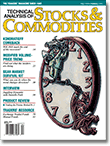 Editor,
Editor,
In the April 2010 article by David Hawkins, “Modified Volume-Price Trend Indicator,” the formula requires an opening price, but my data service only provides H , L, and C prices. So I modified the formula as follows:
AvgFour:=(H+L+C)/3
Could you or the author tell me whether the usefulness of the indicator remains as good with this change?
—Paul Gertler
David Hawkins replies:
Your calculation will have very little effect on the indicator and can be used with confidence.
SHERIDAN METHOD
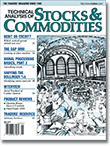 Editor,
Editor,
In “Triple Theta, Half The Time” (May 2010), John Sarkett represents that, “After nearly 25 years as a Mercury Trading market maker specialist in the Cboe pits, Sheridan founded his company in 2007.” Oddly, the article goes on to discuss how Francisco Urrutia became a Sheridan student in 2006. How could this be if Sheridan did not start his company until 2007?
The answer is that Sheridan is instead a 22-year pit veteran and truly started his company in 2004 in a close partnership with OptionVue Systems International. All of Sheridan’s customers came from OptionVue during those years, including Francisco Urrutia. OptionVue helped develop course materials, teach the students, and managed most all administrative details of the operation. But since Sheridan’s mentoring company and ours, DiscoverOptions Mentoring, now compete with each other, it seems the author chose to revise history a bit.
John Sarkett’s articles are generally pretty good. We had expected better from him.
—Len Yates, president
OptionVue Systems International
John Sarkett replies with these clarifications:
- Dan Sheridan actually founded Sheridan Options Mentoring in 2004 (not 2007 as I stated in my article) after leaving Mercury Trading. OptionVue served as the exclusive distributor of Sheridan Mentoring educational services. In a phone conversation, Sheridan told me he developed the option-trading course materials and provided direct mentoring/education services via some 40 webinar sessions per week; meanwhile, OptionVue provided its state-of-the-art option software and administration. The two firms collaborated successfully for some three years from offices in Libertyville, IL, but in 2007 Sheridan elected to end the collaboration and took on administrative functions himself. He continued to use OptionVue software in his webinars and teaching, however, through 2009.
- Dan Sheridan met Francisco Urrutia at a seminar in Orlando sponsored by both Sheridan Options Mentoring and OptionVue. Sheridan continued to work with Urrutia after that for some time.
- The two firms do indeed compete now, both in mentoring services and software (especially since the introduction of Sheridan Options Mentoring’s Options Explorer software in 2010).
Hope this clarifies the history and relationship of the two firms, as well as some of the educational path of supertrader Francisco Urrutia.
INTERVIEW WITH JAY KAEPPEL
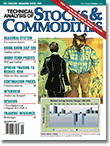 Editor,
Editor,
In your interview with Jay Kaeppel in the November 2009 issue, at the end of the interview, Kaeppel describes a system using Fidelity Sector funds, investing in the top five funds monthly, based on annual returns.
Tracking this during the past six months, it seems to outperform the S&P 500 by about 1% per month, although during market corrections it seems to underperform.
Kaeppel describes the experience in late 2008 and early 2009. It seems going to cash was accidental, and the system was still mostly in cash in late 2009. He refers to an article that is 20 years old. In your Traders.com magazine [no longer published—Ed.], I have seen a few articles where the subject of the article is some type of market timing system and the Fidelity Sector funds were the investment vehicle. They used the 13-week relative performance.
I was wondering whether there are any recent articles that describe trading systems for investing in Fidelity Sector funds — first, how to select funds with the best chance of good relative performance, and second, what to do in a market correction, or a simple method of identifying high-risk market situations.
—Robert Schwarz
The articles that Kaeppel mentions in the interview appeared in the July 1999 and November 1999 issues of S&C (which, incidentally, makes them 10 years old at the time of that writing, not 20):
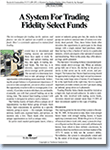 JULY 1999
JULY 1999
A System For Trading Fidelity Select Funds
by Jay Kaeppel
The key techniques for trading stocks, options, and futures can also be applied successfully to mutual funds. Here’s a systematic approach to mutual fund trading.
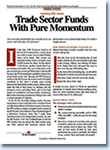 NOVEMBER 2001
NOVEMBER 2001
Trade Sector Funds With Pure Momentum
by Jay Kaeppel
In the July 1999 Technical Analysis of Stocks & Commodities, I wrote about one of the systems I use to trade Fidelity Select sector funds. That system was referred to as the relative strength system (or RS System for short). In this article, I will discuss another system that I use for trading sector funds. This one is referred to as the pure momentum system (or PM System).
Readers can read free excerpts from the articles at:
https://www.traders.com/documentation/feedbk_docs/1999/07/Abstracts_new/Kaeppel/Kaeppel.html
and
https://www.traders.com/documentation/feedbk_docs/2001/11/Abstracts_new/Kaeppel/momentum.html
at our website, Traders.com. We have not featured any articles recently on trading systems specifically for Fidelity Select funds, but from time to time you will find articles on various Fidelity Select funds at our online publication, Traders.com Advantage.
However, we have in the past published articles in Stocks & Commodities that discuss techniques for trading mutual funds. These include:
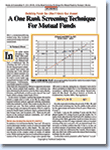 JANUARY 2005
JANUARY 2005
A One Rank Screening Technique For Mutual Funds
by Norman J. Brown
Here’s a momentum-following method using three technical analysis tools to help switch your mutual funds.
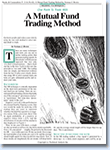 JUNE 2003
JUNE 2003
A Mutual Fund Trading Method
by Norman J. Brown
Get better profits and reduce your risks by using the one-rank method to select mutual funds to trade.
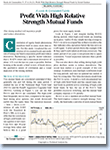 APRIL 2009
APRIL 2009
Profit With High Relative Strength Mutual Funds
by Gerald Gardner
This timing method will maximize profit and reduce drawdown.
You can use the search engine at our site to help locate articles. —Editor
IRAs AND BEAR MARKETS
 Editor,
I am new to trading. I won’t complete my training for another six months. So I have a very basic question. I will be using a self-directed Ira to fund my trades. Thus, I will not be able to do shorting. So, is it otherwise possible to do profitable trading in an down-trending bear market? If so, what method would I use?
Editor,
I am new to trading. I won’t complete my training for another six months. So I have a very basic question. I will be using a self-directed Ira to fund my trades. Thus, I will not be able to do shorting. So, is it otherwise possible to do profitable trading in an down-trending bear market? If so, what method would I use?
—Vince Kasprzak
These days, there are some options for trading in your individual retirement account (Ira) when you have a bearish stance on the markets. While you still cannot short individual stocks within an Ira per Irs rules, you can buy bearish exchange traded funds (Etfs). You will find a list of bearish Etfs here:
https://etf.stock-encyclopedia.com/category/bearish-etfs.html
or check with your broker. Stay with high-volume Etfs so that you can get in and out of the market quickly.
For more about bearish Etfs and whether they may be right for your portfolio, here are two past articles we’ve published (available from the store at Traders.com):
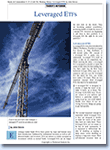 DECEMBER 2009
DECEMBER 2009
Leveraged Etfs
by John Devcic
If you’re into short-term index strategies, a leveraged Etf could be just what you need.
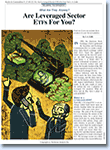 OCTOBER 2009
OCTOBER 2009
Are Leveraged Sector Etfs For You?
by L.A. Little
Find out if you can include these products in your list of tradables.
CHARTING PACKAGES AND TRADING SYSTEMS
Editor,
I am looking into trading systems and charting software. I am wondering how these compare. I am having difficulty selecting one over another. Can you help?
—Greg Gann
While it’s not within our magazine’s mission to rank and report results of trading systems, every issue we publish reviews of various technical analysis packages and charting software. (In this issue, look for a review of StockCharts.com.) Browse for past reviews at our website at
https://www.traders.com/Documentation/FEEDbk_docs/backissues.html
by clicking on a year, month, and contents.
As for independent reporting on the results of commercial trading systems, check out Futures Truth (www.futurestruth.com/aboutus.htm), a publication that has offered since 1985 objective, third-party rankings of some futures trading system returns. Also see Collective2 (www.Collective2.com), a service that monitors nearly 12,000 trading systems (commercial or user-submitted) and shows results. —Editor
ON BECOMING A SUCCESSFUL FOREX TRADER
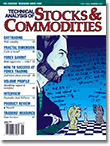 Editor’s note: The following is a selection of letters that author Leslie vanWinkle received about her June 2010 article in S&C, “Becoming A Successful Forex Trader”:
Editor’s note: The following is a selection of letters that author Leslie vanWinkle received about her June 2010 article in S&C, “Becoming A Successful Forex Trader”:
Wow! I’m sure you’ve heard this many times, but the article “Becoming A Successful Forex Trader” (Stocks & Commodities, June 2010) described my life with an eerie precision. I too have learned much about myself — things I don’t think I could have changed without that mysterious motivation that trading gives to a person’s resolve. I found the book Trading In The Zone by Mark Douglas to be an excellent book as well.
I just had to write a few lines and say thanks for the excellent reading.
—Brian
I agree that trading is a mental game. I always say, it’s 10% skill and 90% psychology.
I am also at my fifth year [of forex trading], and for the last five months I have been profitable. So we are in the same boat somehow.
What I would like to add is that time spent in front of the screen is needed to acquire this “feeling” for the market. Then you learn to “see” the correct support and resistance, trendlines, and so on.
I wish you all the best with your trading.
—Vassilis, Greece